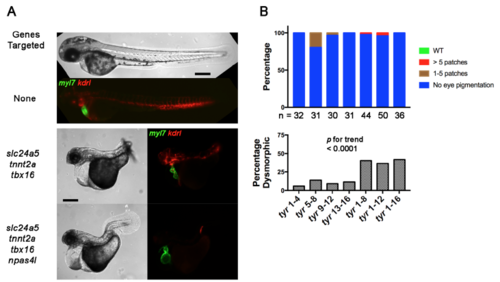Fig. S4
- ID
- ZDB-FIG-180827-31
- Publication
- Wu et al., 2018 - A Rapid Method for Directed Gene Knockout for Screening in G0 Zebrafish
- Other Figures
- All Figure Page
- Back to All Figure Page
|
Cas9 RNP Toxicity Increases with sgRNA Number. (Related to Figure 4) (A) Brightfield and epifluorescence images of embryos carrying the Tg(myl7:GFP) cardiomyocyte and Tg(kdrl:rasCherry) endothelial/endocardial markers at 2 dpf. Embryos were left uninjected or cellinjected with multiple four-guide Cas9 RNP mixes targeting slc24a5, tnnt2a, and tbx16, or slc24a5, tnnt2a, tbx16, and npas4l as indicated. Expected phenotypes were present in combination, but the percent of dysmorphic embryos (middle and bottom panels) was high with complex guide sets. Scale bars 250 μm. (B) Percent of embryos with expected phenotype and percent dysmorphic after injection of increasing numbers of guides targeting a single gene. Embryos were yolk-injected with each of four four-guide sets targeting tyr or with these sets in combination such that embryos received 4, 8, 12, or 16 guides. Embryos received the same total amount sgRNA and Cas9 protein independent of guide number. The number of non-dysmorphic embryos analyzed is shown for each condition. Increased guide number was associated with increased toxicity; p < 0.0001 by Chi-square for trend. Scoring was performed blind to treatment. Experiments were performed at least twice with similar results. |
Reprinted from Developmental Cell, 46, Wu, R.S., Lam, I.I., Clay, H., Duong, D.N., Deo, R.C., Coughlin, S.R., A Rapid Method for Directed Gene Knockout for Screening in G0 Zebrafish, 112-125.e4, Copyright (2018) with permission from Elsevier. Full text @ Dev. Cell

